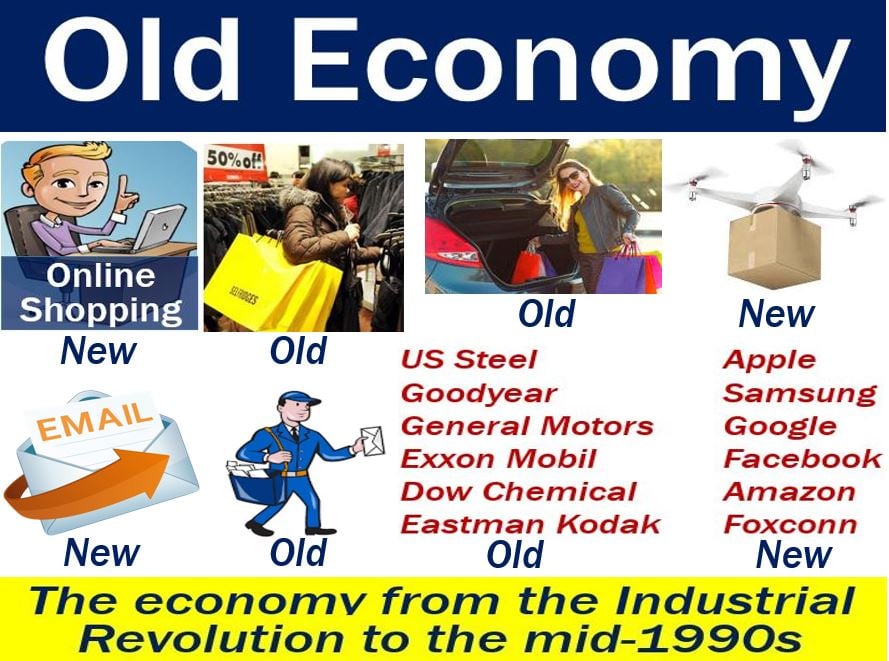The old economy may refer to the economy of the 20th and 19th centuries where manufacturing and agriculture dominated. It contrasts with the new economy. When we say ‘old economy,’ we may refer to a former economic system or state. Additionally, we might mean the old blue chip industries that existed before today’s high-technology companies emerged.
We consider the automotive, energy, and steel industries as part of the old economy.
The old economy was born during the Industrial Revolution. In other words, when we started mass-producing physical products. In that period of our history, we valued objects according to their physical attributes.
Today’s high-technology companies represent part of the new economy. Since the arrival of the new economy, things have changed. Traditional companies still experience growth today. However, they are now growing at a much slower rate.
Old economy vs. new economy
Since the late 1990s, when the Internet and hi-tech products entered the marketplace, the economy has changed. Put simply; the old economy began to lose dominance as the new economy expanded.
The new economy refers to today’s high-growth industries. They are on the cutting edge of technology. In other words, the new economy refers to an economy where hi-tech companies dominate.

Today, in fact, hi-tech companies are now the driving force of GDP growth. GDP stands for Gross Domestic Product.
Not only do hi-tech companies focus on the internet, but also on biotech. The ripple effect of their new technologies has spread to every sector of our economy.
Not even the major traditional companies can manage today without hi-tech products and services. The Ford Motor Company, for example, would grind to a halt with no computers, robots, or Internet.
Put simply; the old economy existed before the 1990s. The new economy emerged in the 1990s thanks to the Internet, the online world, and more powerful computers.
Transformation of workforce dynamics
The labor force in the old economy was characterized by lifelong careers in single industries, with job security often tied to large corporations and labor unions.
Today, the landscape of employment has transformed, with a shift toward the gig economy, remote work, and careers spanning multiple sectors, reflecting the adaptability required in the rapidly evolving job market.
The gig economy refers to one in which employers hire independent contractors and freelancers rather than full-time workers. The number of temporary positions increases in a gig economy, while full-time permanent positions decline.
Old vs. new economy in retailing
Retailing has changed considerably since the turn of this century. A growing number of retail sales are taking place online. Globally, hundreds of thousands of physical shops are closing down each year.
Shopping in the past involved going into a store, choosing something, and then paying for it. Sometimes we would try on things, such as clothes or shoes. All this would happen inside the physical store.
Today, a growing number of consumers go online, select their product, and pay for it also online. They then receive their purchase via courier or through the post. We even have drones that deliver goods that people have bought online.
The retail sector of the old economy will soon be something we can only know about in history books. Economists wonder what will happen to the thousands of shopping malls across the world.
Some shopping malls have adapted to a certain extent. They have tried to turn themselves into entertainment, cafe, gourmet, and fun centers. However, many have had to close down.
More old & new economy examples
The list below highlights how some common old economy actions have changed since the advent of the Internet.
- Old – Reading print newspapers and magazines.
New – Accessing news online through digital platforms. - Old – Listening to music on vinyl, tapes, or CDs.
New – Streaming music on digital platforms. - Old – Writing letters by hand and sending them via postal mail.
New – Sending emails and instant messages. - Old – Going to the bank for transactions.
New – Online banking and mobile payments. - Old – Shopping offline in physical stores.
New – Online shopping and home delivery. - Old – Watching movies in theaters, video tapes, or on DVDs.
New – Streaming movies online. - Old – Taking a taxi hailed from the street.
New – Using ride-sharing apps. - Old – Buying physical maps and guidebooks for travel.
New – Using online maps and travel apps. - Old – Booking hotels over the phone or through travel agents.
New – Booking accommodations online. - Old – Using encyclopedias and libraries for research.
New – Using search engines and online databases. - Old – Attending live classroom training.
New – Participating in online courses and webinars. - Old – Viewing photos in albums.
New – Sharing photos on social media platforms. - Old – Using a phonebook to find contact details.
New – Searching for contacts online. - Old – Placing classified ads in newspapers for selling/buying.
New – Posting on online marketplaces. - Old – Using a film camera and developing photos.
New – Taking pictures with digital cameras or smartphones and sharing them instantly. - Old – Cooking with recipe books.
New – Finding recipes online and watching cooking videos. - Old – Visiting a doctor’s office for consultation.
New – Telemedicine and online health consultations. - Old – Physical fitness journals.
New – Using fitness tracking apps and wearables.
